Homemade Sourdough Bagels – With Video
Sourdough bagels are chewy, crusty and properly dense. They have an extra deep flavor thanks to the sourdough starter in the recipe. This recipe take more than 12 hours to make, but the vast majority of the time is hands-off.

I’ve said it before, I think a good bagel should have a nicely dense and chewy texture with a toothsome crust. Forget the frozen hockey pucks from the grocery store, and the bagels from chain bakeries that are way too fluffy to be a real bagel.
Homemade bagels are not hard to make and they freeze beautifully. If you set aside a little time over a weekend, you can stock up the freezer for weeks to come.
This Sourdough Bagel recipe is a variation of my popular recipe for New York Style Bagels.
If you don’t already have one, I can show you how to make a sourdough starter and how to feed a sourdough starter.
Ingredients
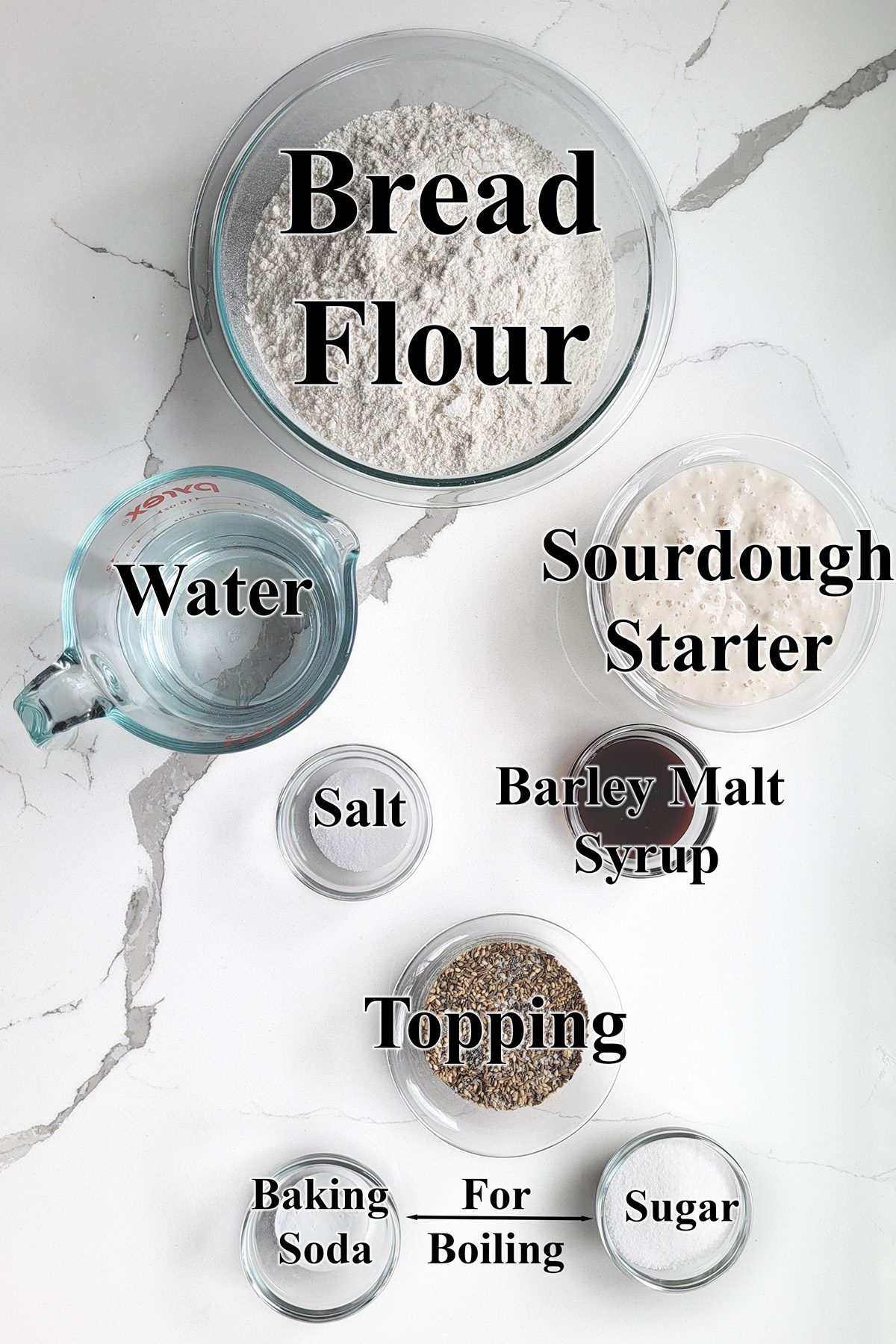
Ingredient Notes
- Bread Flour – Bagels should have a very chewy crumb from a strong gluten network in the dough. High protein bread flour develops plenty of gluten.
- Sourdough Starter – The recipe was developed using 100% hydration starter. You will need to adjust the liquid or flour in the recipe if you’re starter isn’t at 100% hydration. Your starter should be fed and active when you mix the bagel dough.
- Barley Malt Syrup – Adds a traditional slightly sweet note to the dough. You can substitute honey or a combination or honey and molasses for the barley malt syrup.
- Toppings – Leave the bagels plain or use your favorite seed for topping. You can mix seeds with salt to make your own “everything” bagel topping”. See the recipe card for details.
- Baking Soda & Sugar – For boiling the bagels. The boiling process creates the specific shiny and chewy bagel crust.
Process photos for making Sourdough Bagels
See the recipe card for detailed measurements and instructions.
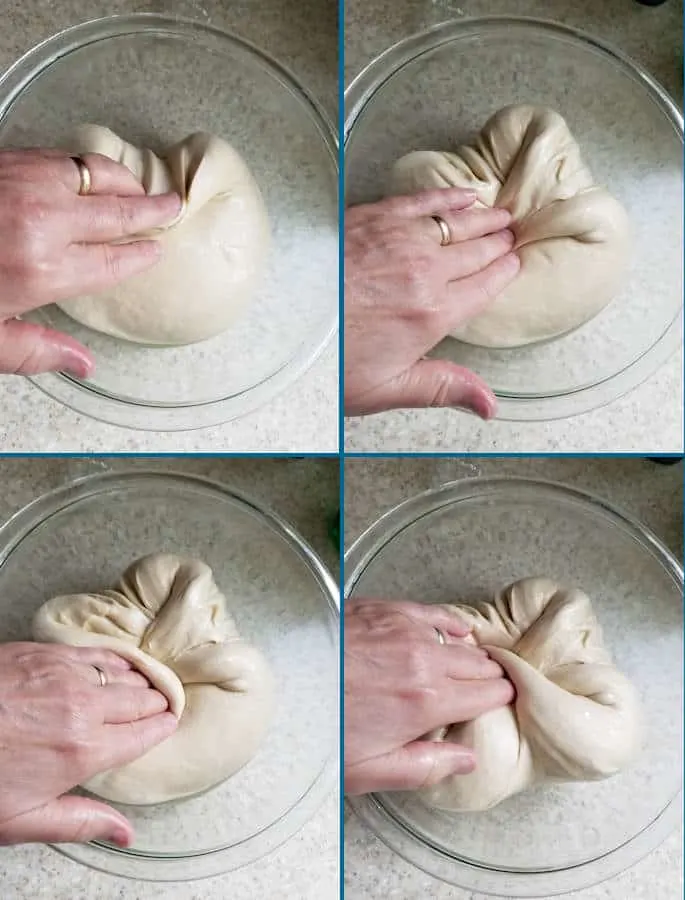
- As the dough ferments, it should be folded onto itself every hour or so to redistribute the yeast.
- Fold from each side into the middle, then flip the dough over.
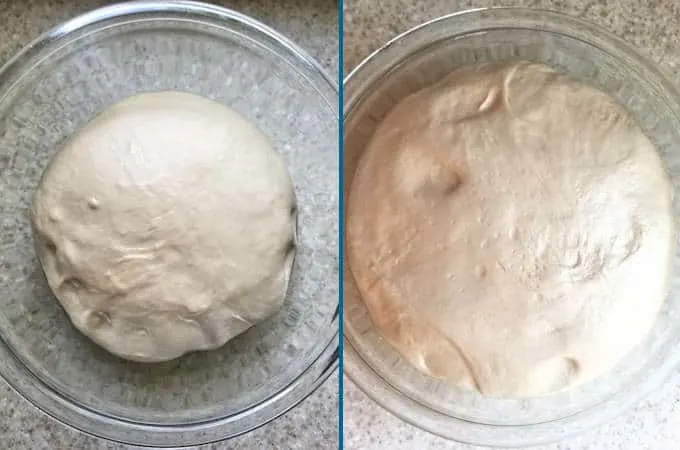
- After 30 minutes there’s not much activity in the dough (left).
- After 3 hours the dough should be active and nicely aerated (right).
- After fermentation it’s time to shape the bagels.
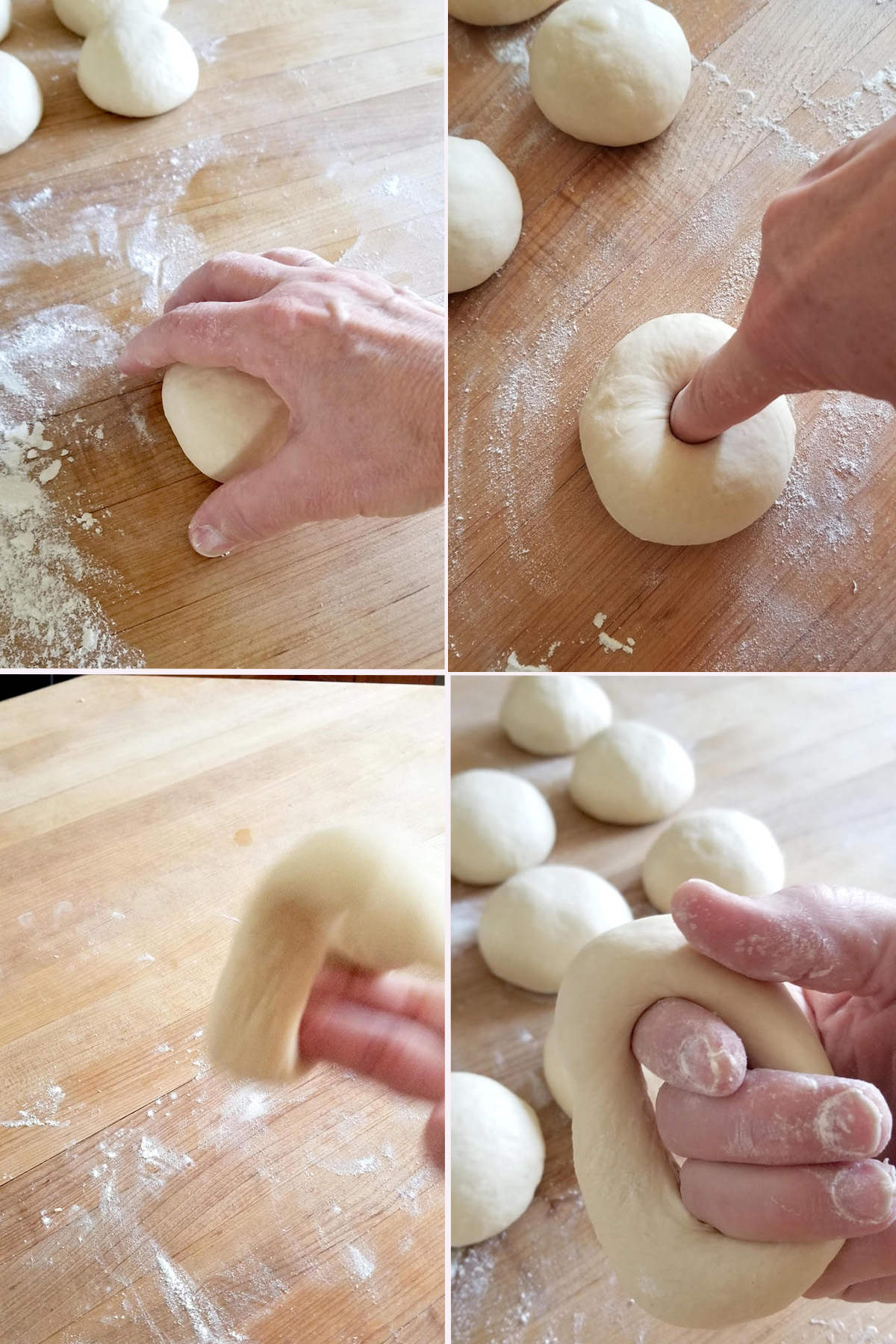
- Use a cupped hand to form the a piece of dough into a tight ball. Repeat with all the pieces of dough.
- Poke your finger all the way through the center of the ball to make a hole.
- Twirl the dough around your fingers to widen the center hole.
- Set the bagel onto the baking sheet and continue with the rest of the dough.
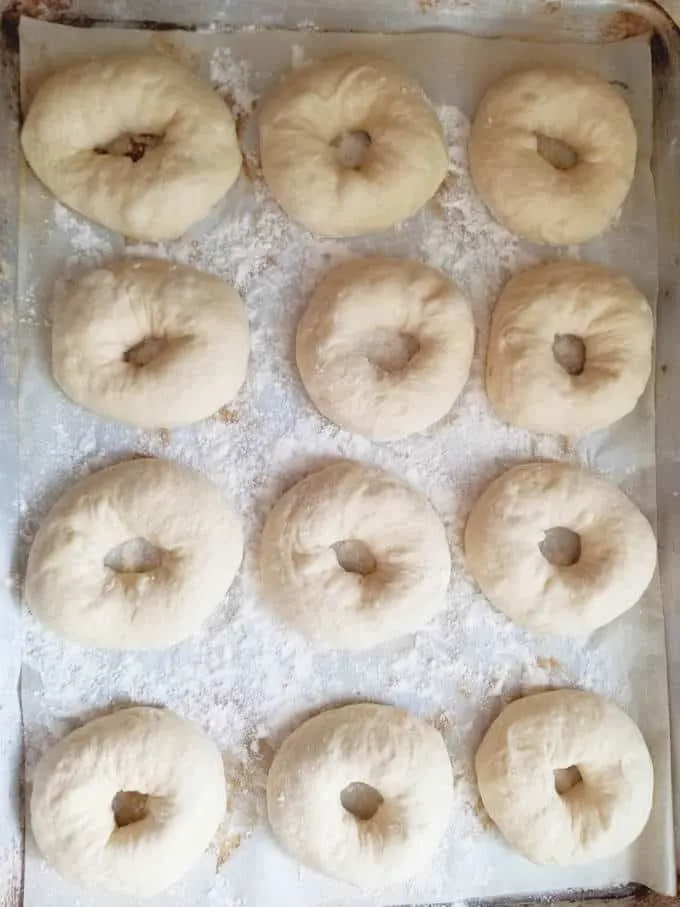
- Line the formed bagels onto a well-floured (or use cornmeal) sheet pan to prevent sticking.
- Cover the pan and place it in the refrigerator overnight.
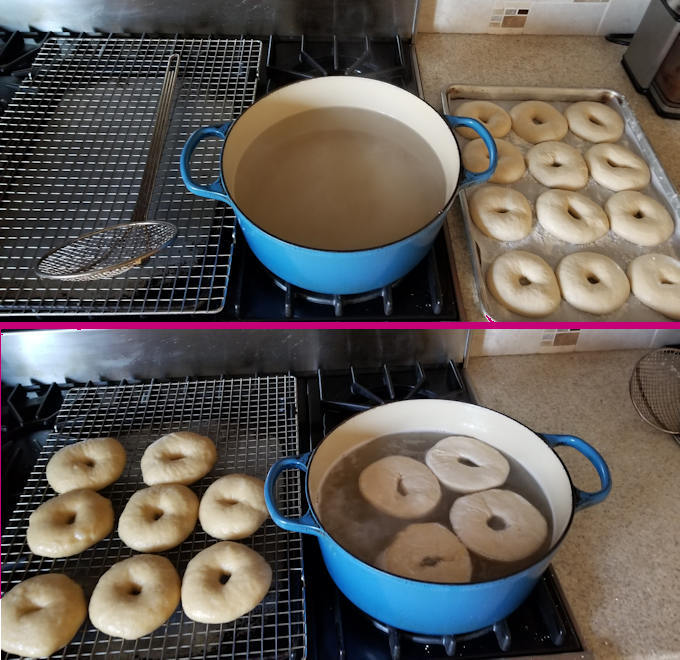
- Bring a pot of water with baking soda and sugar to a boil. Preheat the oven.
- Boil the bagels a few at a time, flipping them every thirty seconds. Boil each batch for 2 minutes.
- Transfer the bagels to a rack to drain while you finish boiling the rest of the bagels.
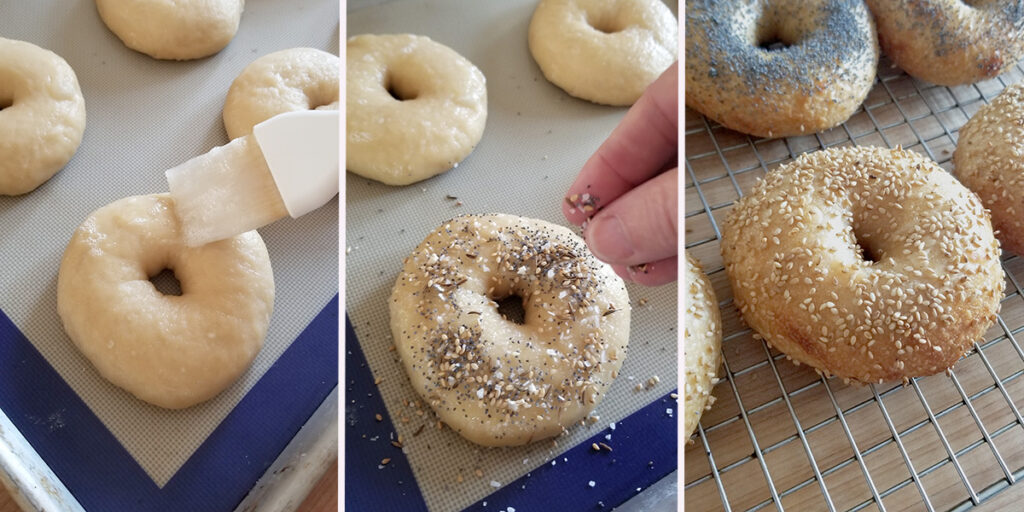
- Brush the boiled bagels with egg white.
- Sprinkle seeds or bagel topping if desired.
- Bake until the bagels are golden brown.
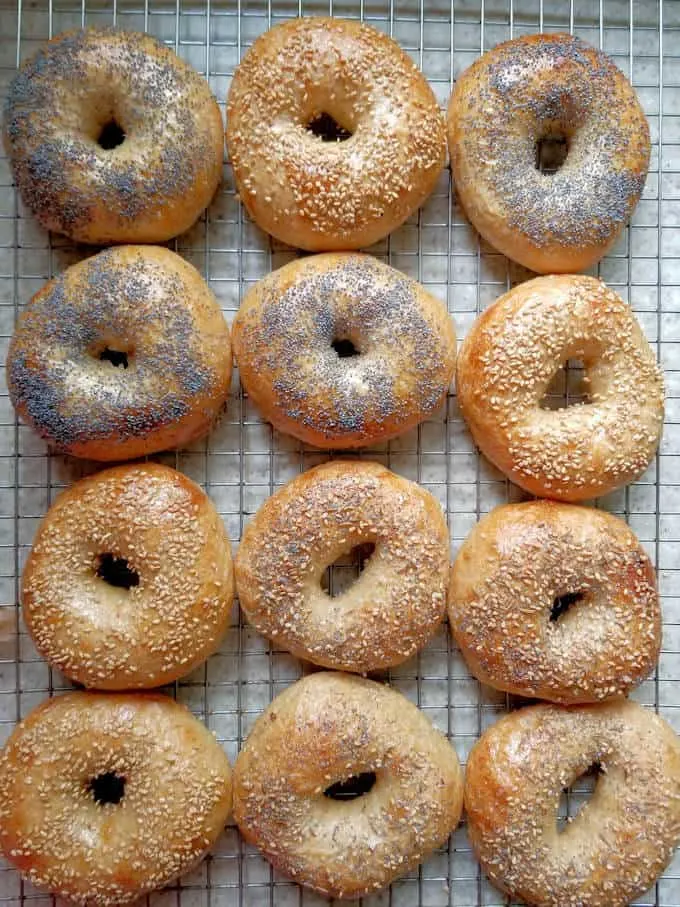
Recipe Tips
- Make sure your starter is very active and lively. I get the best results when I do two feedings in the days before making this dough. I keep several starters and use the Small Starter for this recipe because it requires two feedings before baking with it.
- To get a good bagel shape that will rise properly, you must create a tight ball of dough before making the ring. Use a cupped hand and surface friction to roll the dough into a ball. You can see how it’s done in the recipe video.
- Place the shaped bagels on sheet pan which has been sprinkled liberally with cornmeal or flour. If the bagels stick to the pan you will loose volume when transferring them to the water. I find cornmeal works best, but flour will work too.
- In the morning, take the bagels out of the fridge and leave them out until the dough comes to room temp.
- Don’t start boiling the bagels until the oven is preheated. They should go into the oven within minutes of coming out of the water.
Storage
- Bagels are best the day they are baked. For longer term storage, slice the bagels about 3/4 the way through and pack them into freezer bags.
- Previously frozen bagels are best if toasted before serving.
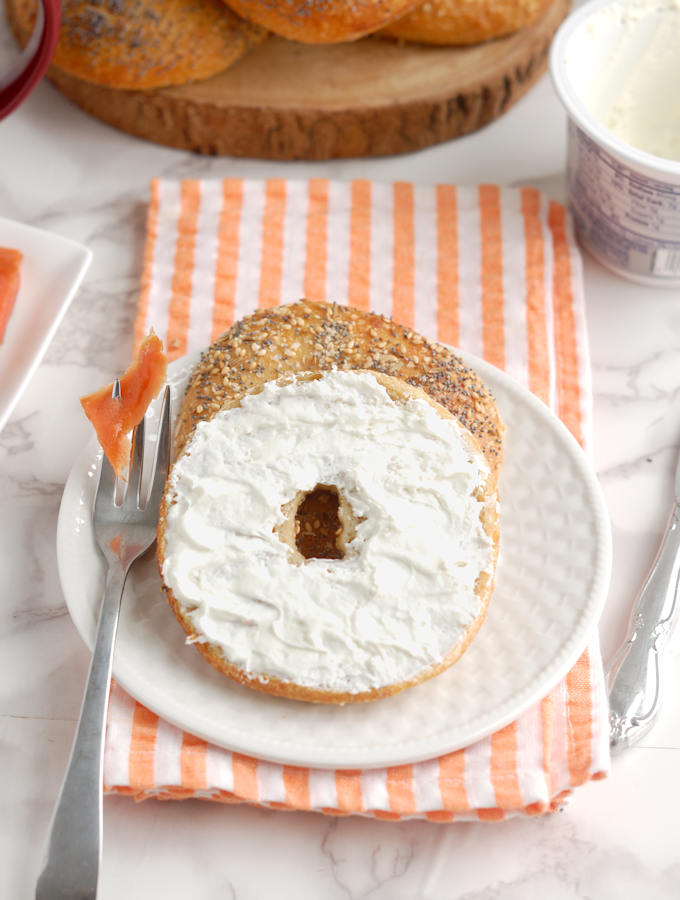
I know you hate to throw away that sourdough discard. Check out these recipes that use sourdough discard.
If you love this recipe as much as I do, please consider giving it a 5-star review.
Sourdough Bagel Recipe
Ingredients
- 8 oz active sourdough starter (1 cup (100% hydration))
- 12 oz warm water (1 ½ cups)
- 22 ½ oz bread flour (4 ½ cups, divided, see note)
- 1 ½ oz barley malt syrup (2 tablespoons (or honey + molasses))
- 1 tablespoon table salt
- 2 oz granulated sugar (¼ cup (for boiling))
- 2 teaspoons baking soda (for boiling)
- corn meal (for pan prep)
- 1 egg white (whisked lightly)
- Topping (sesame seeds, poppy seeds, caraway seeds or coarse salt)
Instructions
- Combine 8 oz active sourdough starter, 12 oz warm water and 2 cups (10 oz) of the flour in a mixing bowl. Mix to form a thick batter. Cover the bowl and set aside for 30-60 minutes.
- Add 1 ½ oz barley malt syrup and 1 tablespoon table salt. Switch to the dough hook. Add the remaining 2 ½ cups (12 ½ oz) flour and mix to combine. The dough should eventually cling to the hook and start to clear the sides of the bowl.
- Knead 5 minutes on medium speed. If working by hand, stir in as much of the flour as you can, then turn the dough out onto a lightly floured surface and knead in the remaining flour. Knead 5 minutes. Form the dough into a smooth ball.
- Put the dough into a lightly oiled bowl, turning once to coat the dough. Cover the bowl and set it aside at room temperature. After 30 minutes uncover the bowl, lift one side of the dough and fold it into the middle of the dough. Repeat with the other three sides of the dough then flip the dough over. You're basically turning the dough inside-out to redistribute the yeast. Cover the bowl and repeat the procedure every 60 minutes for a total fermentation time of about 3 hours. The dough should be lively, elastic and airy. If the dough is still sluggish give it another hour or two at room temperature.
- Line a baking pan with parchment paper then generously sprinkle the paper with cornmeal (or flour). Turn the dough out onto a lightly floured surface without kneading out the air. Divide the dough into 10 even pieces. Use a cupped hand to roll each piece into a smooth, tight ball.
- To form a bagel, poke your finger all the way through the center of a ball to make a hole. Use two fingers to gently open up the hole. Continue gently stretching to form the bagel or twirl the dough around your fingers to widen the center hole to 1 – 1½" wide.
- Place the bagel on the prepared sheet pan and continue to form the remaining bagels. The dough will probably spring back a bit so you can go back and re-stretch the holes once you're done forming all the bagels. Cover the pan with plastic wrap. If the dough and the ambient temperature is on the cooler side, leave the shaped bagels at room temperature for 30 minutes then place the pan in the refrigerator overnight. If the dough and ambient temp is warmer and the dough is quite active, place the bagels into the refrigerator without leaving them out for 30 minutes.
- In the morning take the bagels out of the refrigerator and bring them to room temperature.
- Preheat the oven to 450 °F. In a large pot combine 1 gallon of water with 2 oz granulated sugar and 2 teaspoons baking soda and bring it to a boil. Reduce the heat to keep the water at a rolling simmer. Set a cooling rack over a sheet pan or kitchen towel and place it next to the stove. Line two half-sheet pans with parchment paper or silicone baking mats and generously sprinkle with corn meal.
- Once the oven is preheated, you're ready to boil. Gently lift a bagel off the sheet pan and lower it into the water, bottom side down. Depending on the size of your pot, you can boil 3-4 bagels at a time. Boil the bagels for 30 seconds then flip them. Boil the other side for 30 seconds. Repeat the process again for a total of 2 minutes boiling time. Remove the boiled bagels from the water and set them on the cooling rack to drain.
- Place 5 of the boiled bagels on each sheet pan. You could fit them all on one pan but they may stick together as they bake.
- Brush the bagels with egg white. Add the topping(s) of your choice. To make "everything" bagels combine a tablespoon of each of sesame seeds, poppy seeds & salt with a 1/8 teaspoon garlic powder and onion powder. Bake until golden brown, about 20 minutes.
Would you like to save this recipe?
As an Amazon Associate and member of other affiliate programs, I earn from qualifying purchases.









I’ve made this these twice and each time the bagels never floated in the water. They also seemed too sticky. The taste is very good though
I always put the bagels in the water with the bottom side (cornmeal side) down first. Sometimes the bagels can stick to the bottom of the pot if they sink all the way down. Give them a nudge after putting them in the water to make sure they’re not stuck. To avoid a sticky dough make sure your starter is well fed and at it’s most active phase when you mix the dough. Give the sponge 30-60 minutes. Give the dough a full 5 minutes of kneading and plenty of time for the fermentation.
Oh yum! They turned out perfectly!! Thank you for sharing your thoughtful step-by-step! Now I’m really stuck…. I want to share them so I can say “Look what I made!”, but they’re so darn good that I want to keep’em all for meeeee!! Bookmarking….
Ha, ha. I keep making them to “stock up” the freezer, but somehow each batch is gone before the next is made.
Hi in the middle of making these! Question re the gram measurement of flour – if 120g=one cup how does 630g = 4.5 cups? The number for 4.5 cups would be 540g I think. I am def a newer pandemic baker so not sure!. Worried about the ratio! I was so excited to make this – hope you can answer or I figure it out soon. No other questions about it so a little confused.
Hi in the middle of making these! Question re the gram measurement of flour – if 120g – one cup how does 630g = 4.5 cups? The number for 4.5 cups would be 540g. Worried about the ratio! I was so excited to make this – hope you can answer or I figure it out soon. No other questions about it so a little confused.
Where does the 120g measurement of flour come from? I use the weight of 5 oz per cup of bread flour. Assuming 28g per ounce, 1 cup would be 5ozx28=140g. 4.5 cups x 140=630g.
This is what I have been using all along, and I have weighed everythin
The bagels didn’t rise – very flat. I am sure they will taste good, but reciped didn’t work for me clearly.
I’m sure the King Arthur weight chart works for King Arthur recipes. But the weight of a cup of flour can vary based on how you fill the cup. I use the “dip and sweep” method which yields 5 oz per cup. If you always work with weights then you should use the weight listed in the recipe and not worry about the cup measure. Did the bagels not rise at all or did they loose volume when you moved them from the tray for boiling?
Eileen, are you measuring in oz or grams? When I made this recipe and finally decided to weigh out the flour, I weighed in grams. I also had the same problem as Joy, where they fell very flat. I think it’s because I didn’t use enough flour, as it seemed much stickier than the ones I had made in the past. For me, I got better results using a measuring cup, but I would prefer to weigh it.
I weigh everything in oz and then convert to grams for the convenience of readers outside the US or who prefer to use grams. Whether you use oz or grams shouldn’t make a difference. Using cup measure is less accurate since how you fill the cup can change the weight of the flour by as much as an ounce per cup. I think your bagels falling flat may be due to other issues. Most of the time the texture of the dough is affected by the condition of the starter. Bagels falling flat could be because the dough didn’t have good gluten development or they were over-proofed. Weak or over-proofed dough can deflate when you pick up the bagels to put them into the boiling water. I make these bagels almost every week and I find that I need a really active starter to have the best dough. The dough should be nice and tight when you are shaping the bagels.
Hi! I am new to sourdough baking and really want to make bagels as we don’t get good ones here in India. I was wondering if it was possible to make this recipe with whole-wheat flour? I was thinking maybe 500gm WW and 130gm APF? Also I do not have any malt syrup or molasses. I would have to use only honey. Do you think I could still have a good outcome or is it too many changes? Also what should I expect with these modifications? Thank you!
The honey will be a good substitute. Bagels need really strong gluten for the right texture. I’m afraid a combination of whole wheat and all purpose flour (I assume that’s what you mean by APF) wouldn’t develop a strong enough gluten, especially using mostly whole wheat flour. Do you have access to higher protein flour, like bread flour?
I could procure some bread flour. I just thought the WW with the AP might be healthier. There is something called T55 fine wheat bread flour available. Thanks!